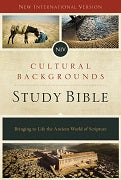Your congregation has heard many Bible stories dozens of times. But are the people in your care missing key behind-the-scenes details into the biblical world that would deepen their understanding and appreciation of Scripture? The NIV Cultural Backgrounds Study Bible is packed with expert insight into the customs and culture of the Bible to help readers discover the rich meaning behind the stories of Scripture.
Take the familiar Bible story of the Tower of Babel, for instance:
- Did your congregation know that the Tower of Babel was likely a ziggurat? That a ziggurat was an ancient rectangular stepped tower, typically accompanied by an adjoining temple? That it was considered a sacred space and off-limits to common people? And that having a ziggurat was immensely desirable because it meant a deity was in their midst and would bring with him or her blessings, prosperity, and protection?
- Did your congregation know that when the tower was to reach into heaven, the aim was not for people to go up to heaven to be where God is, but for God to come down to be where they were?
- Did your congregation know that the desire to “make a name for themselves” was a desire to be remembered? That other ways people chose to make a name for themselves was through having children, through adventures, through conquests, through wisdom, or through massive building projects?
- Did your congregation know that bringing back the presence of God among them through the Tower of Babel was a desire to regain the lost presence of God that resulted from the fall?
- Did your congregation know that the fear of scattering is directly related to the desire to make a name because remembrance took place in the vicinity of the burial ground? And that descendants who move away (as Abraham does in chapter 12) cut the ties of continuity between the past and the present?
- Did your congregation know that God’s answer to people’s selfish desire for a great name at the Tower of Babel is answered with grace in the very next chapter—God’s covenant with Abraham in which He promises to make Abraham’s name great?
The Bible was originally written to an ancient people removed from us by thousands of years and thousands of miles. The Scriptures include subtle culturally based nuances, undertones, and references to ancient events, literature and customs that were intuitively understood by those who first heard the Scriptures read. For us to hear the Scriptures as they did, we need a window into their world.
The NIV Cultural Backgrounds Bible, with notes from Dr. John H. Walton (Wheaton College) in the Old Testament and Dr. Craig S. Keener (Asbury Theological Seminary) in the New Testament, brings to life the ancient world of Scripture for modern readers.
How to Use This Book
- Use it for your own study. The NIV Cultural Backgrounds Study Bible is a convenient one-stop resource for windows into the ancient world.
- Recommend it to your congregation. This is the ideal study Bible for church members who want a resource that will bring the ancient world to life as they read Scripture.

